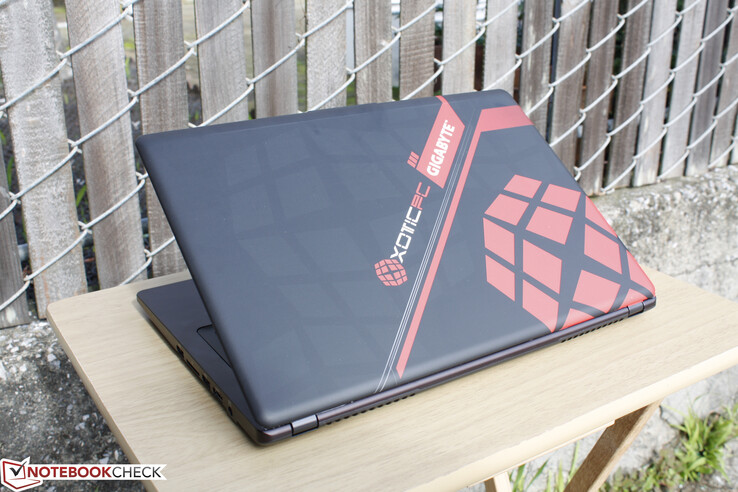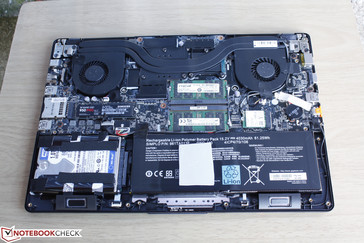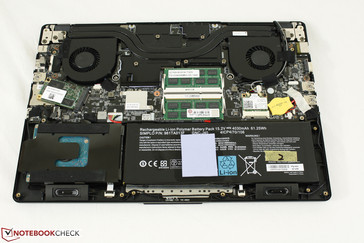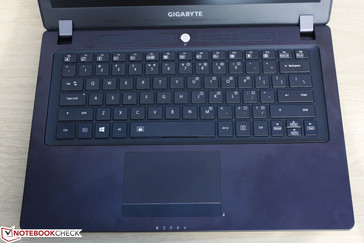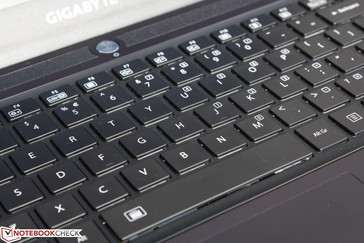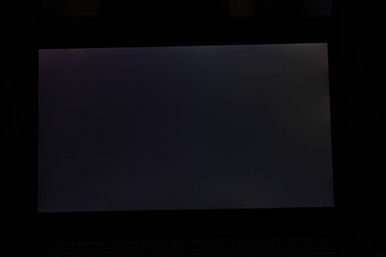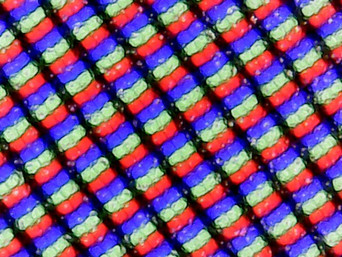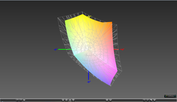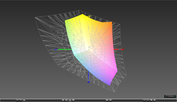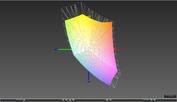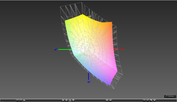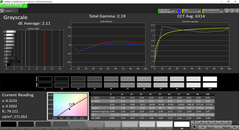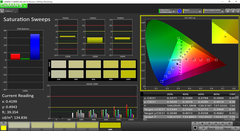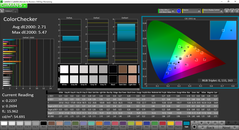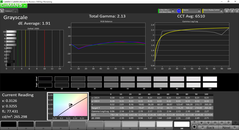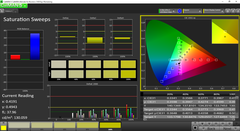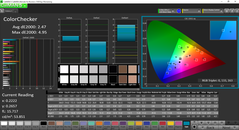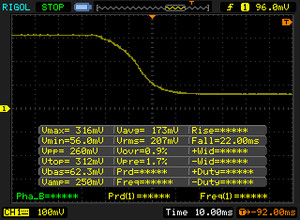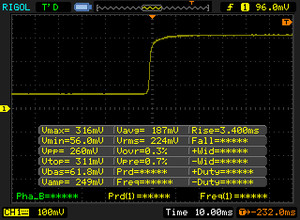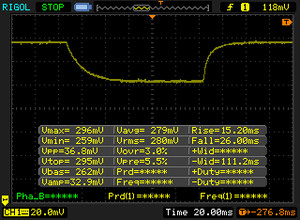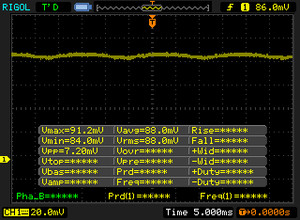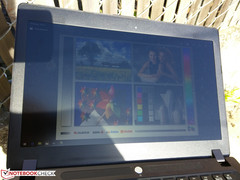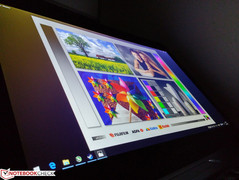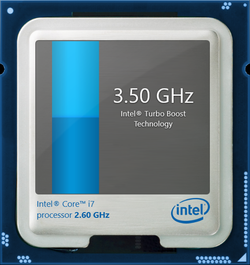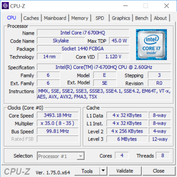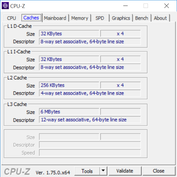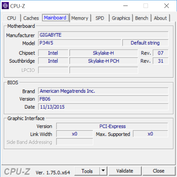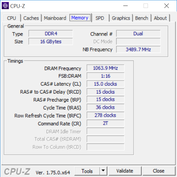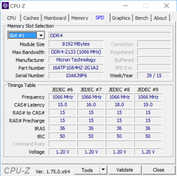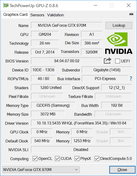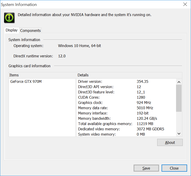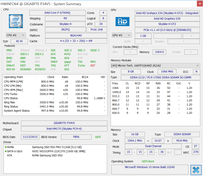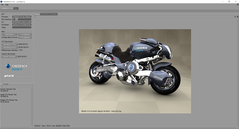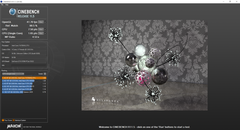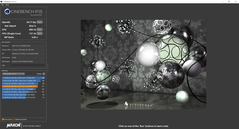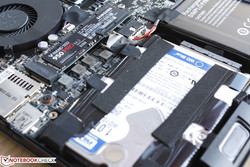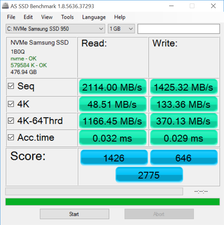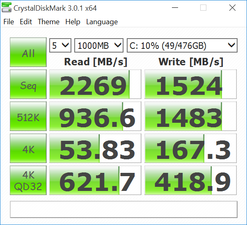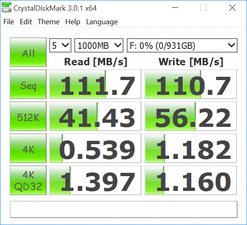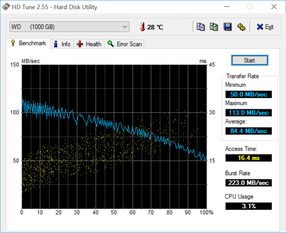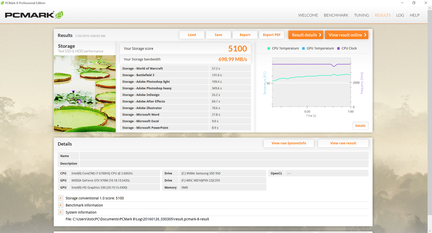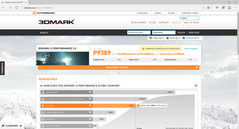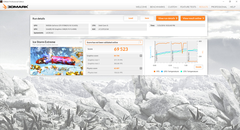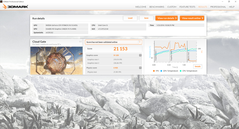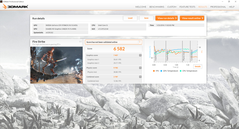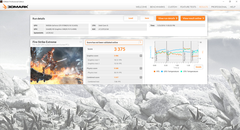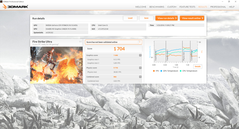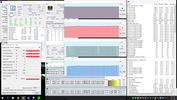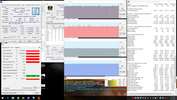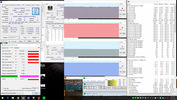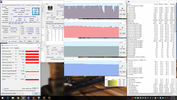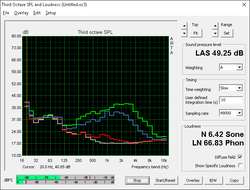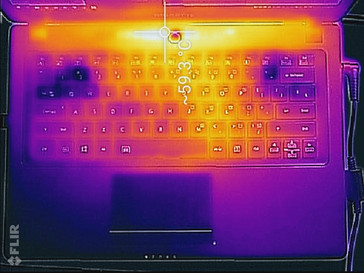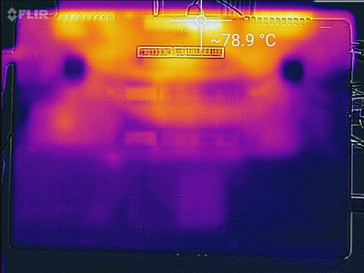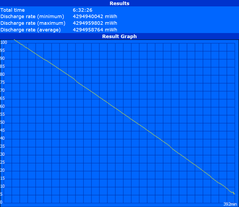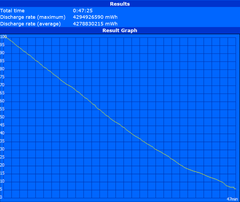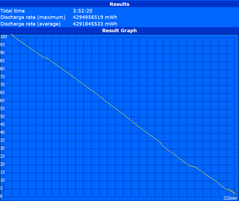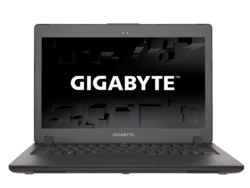Gigabyte P34W v5 Xotic PC Edition Notebook Review
Note: We reviewed a configuration from Xotic PC U.S. There can be differences compared to original manufacturer models in respect of the integrated components (memory, RAM, CPU, GPU, etc.) as well as their configurations. Components may have been overclocked. As a result, there can also be differences in terms of performance, emissions, and battery runtimes. The visual appearance of the devices can differ as well.
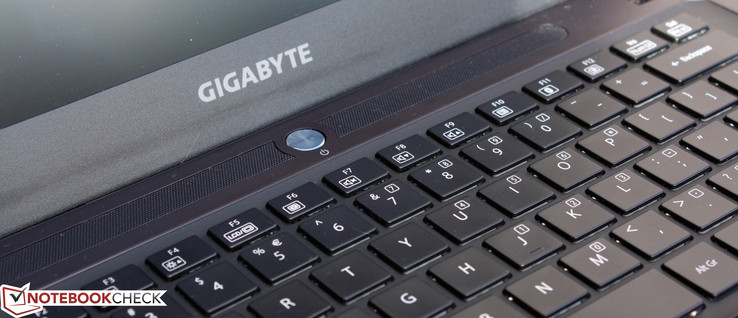
Gigabyte has carved itself a small but lucrative niche in the gaming market by offering only super-thin and lightweight gaming notebooks that are half the size of competitors without sacrificing core hardware performance. It's true that these Gigabyte notebooks pack more power than their reserved demeanor would otherwise suggest, albeit naturally at the cost of fan noise and heat.
Now in its fifth generation, the P34W v5 shares the same chassis and features as its third generation SKU with only a few minor external updates. Thus, we recommend checking out our review on the P34W v3 for more pictures and information on chassis quality and input devices. Competition in this space is limited compared to the crowded and more popular 15.6-inch and 17.3-inch categories. Notable alternatives to the P34 series include the Razer Blade 14, Aorus X3, and the recently released MSI GS40.
Has the jump to Skylake improved performance or heat development for this 14-inch gaming station?
Case
Gigabyte has skipped out on any major chassis upgrades to its P34 series likely due to its already super-thin profile and the fact that there's really no rush for a big refresh in the limited 14-inch gaming space. Nonetheless, the Razer Blade 14 is still 3 mm thinner and even a couple hundred grams heavier due in part to its glass touchscreen option that the Gigabyte is lacking. The similarly equipped MSI GS40 is just slightly thicker and larger than our Gigabyte while weighing almost exactly the same at 1.8 kg each.
The latest 15.6-inch P35 was embellished with new Orange accents and some slight curves to its lid. Although we weren't expecting a complete hardware redesign, we would have appreciated similar exterior treatments to further separate the P34W v5 from its earlier iterations even if they are only cosmetic. As it stands, the matte black and rounded edges and corners are becoming blander compared to newer 14-inch solutions.
Connectivity
Available ports remain largely unchanged with just a couple of updates from our last P34W v3 test unit. First, one USB 3.0 Type-A port has been dropped in favor of a USB 3.1 Type-C Gen. 2 port capable of transfer rates of up to 10 Gbps. Thunderbolt, however, does not appear to be supported. Meanwhile, its HDMI-out port has been upgraded from 1.4 to 2.0 for higher bandwidth and refresh rate support. We especially like the fact that the legacy VGA-out port is still available on a gaming notebook of this size.
When compared to the GS40, the P34 v5 includes VGA and more USB ports, though it lacks mDP as a trade off.
Communication
WLAN gets an upgrade from an Intel 7260 on our previous P34W v3 to the third generation Intel 8260. The dual-band 2x2 module supports theoretical transfer rates of up to 867 Mbps with integrated Bluetooth 4.2. We experienced no connectivity issues specific to the system. It's worth noting that Gigabyte has moved to the M.2 2230 form factor for the WLAN card from the larger half-mini PCIe slot on the P34W v3. Other features like WWAN or GPS are not supported on this gaming-centric notebook.
Accessories
Included extras beyond the AC adapter are light as users will get a PowerDVD 12 media disc, Drivers and Utilities disc, warranty card, and user's manual.
Maintenance
The panel underneath can be easily removed with a single Philips screwdriver. The small hatch allows for quicker access to the two RAM slots, though we're a bit puzzled as to why there is no convenient hatch for the HDD as well.
Warranty
Gigabyte offers 24-month worldwide warranty for most of its notebooks, which is a full year longer than a handful of manufacturers in North America. Batteries and AC adapters are covered for only the first year while other bundled accessories are not covered at all. Xotic PC is responsible for any custom parts on the notebook.
Input Devices
Keyboard & Touchpad
The input devices on the P34W v5 are identical to our P34W v3 unit. While feedback is satisfactorily firm despite the shallow travel, the backlit keys tend to wobble in place and clatter more as a result when typing. The Space bar is also a bit on the soft side and the lack of any auxiliary or dedicated Macro keys may upset some hardcore gamers.
The touchpad (10 x 5.5 cm) is again textured similarly to the arm rests around it with no issues regarding tracking or reliability. It is indeed easier to use than the glossy touchpads on Aorus notebooks as many have been expecting. The dedicated mouse buttons, however, are still soft in feedback and very shallow in travel. This could certainly use improvement should Gigabyte choose to redesign the notebook in the near future.
Display
The P34 v5 series includes options for either a FHD 1080p panel or a WQHD 1440p panel. Our test unit is equipped with the latter and this is certainly a more practical resolution compared to the QHD 1800p display on the Razer Blade 14. The exact LG Philips LP140QH1-SPB1 panel is found on no other notebook in our database and is quite the rare native resolution for a notebook this size offering a PPI of 210.
Subjectively, we can observe no obvious issues as texts and images appear very sharp. There are some slight color grains that may become visible if on the maximum brightness setting while displaying a White background, though this is minor and a common phenomenon on matte displays. Slight to moderate backlight bleeding is visible around the corners that are not noticeable when browsing or word processing. Dim ambient lighting and dark content will accentuate the bleeding.
Compared to the 1080p panel on our older P34W v3, our 1440p panel is slightly dimmer with a narrower color gamut, albeit with higher contrast and more accurate colors out-of-the-box as the trade off.
| |||||||||||||||||||||||||
Brightness Distribution: 83 %
Center on Battery: 277.8 cd/m²
Contrast: 731:1 (Black: 0.38 cd/m²)
ΔE ColorChecker Calman: 2.71 | ∀{0.5-29.43 Ø4.78}
ΔE Greyscale Calman: 2.11 | ∀{0.09-98 Ø5}
76.9% sRGB (Argyll 1.6.3 3D)
48.5% AdobeRGB 1998 (Argyll 1.6.3 3D)
52.8% AdobeRGB 1998 (Argyll 3D)
76.6% sRGB (Argyll 3D)
51.4% Display P3 (Argyll 3D)
Gamma: 2.19
CCT: 6314 K
| Gigabyte P34W v5 14", 2560x1440 | Gigabyte P34W V3 14", 1920x1080 | Razer Blade 14 2015 14", 3200x1800 | MSI GS40-6QE16H11 14", 1920x1080 | Lenovo ThinkPad T450s-20BWS1UT00 14", 1920x1080 | Lenovo Yoga 700-14ISK 80QD 14", 1920x1080 | |
|---|---|---|---|---|---|---|
| Display | 28% | 33% | 20% | 17% | -19% | |
| Display P3 Coverage (%) | 51.4 | 69.4 35% | 70.3 37% | 66.2 29% | 64.8 26% | 41.58 -19% |
| sRGB Coverage (%) | 76.6 | 92.6 21% | 97.1 27% | 85.7 12% | 83.8 9% | 61.8 -19% |
| AdobeRGB 1998 Coverage (%) | 52.8 | 67.4 28% | 71.1 35% | 62.6 19% | 61.2 16% | 43.03 -19% |
| Response Times | 17% | -47% | ||||
| Response Time Grey 50% / Grey 80% * (ms) | 41.2 ? | 31 ? 25% | 52.8 ? -28% | |||
| Response Time Black / White * (ms) | 25.4 ? | 23 ? 9% | 42 ? -65% | |||
| PWM Frequency (Hz) | 198 ? | |||||
| Screen | -11% | -17% | -36% | -5% | -29% | |
| Brightness middle (cd/m²) | 277.8 | 305.4 10% | 318.4 15% | 304 9% | 288 4% | 224.5 -19% |
| Brightness (cd/m²) | 270 | 277 3% | 311 15% | 282 4% | 281 4% | 211 -22% |
| Brightness Distribution (%) | 83 | 84 1% | 78 -6% | 88 6% | 94 13% | 88 6% |
| Black Level * (cd/m²) | 0.38 | 0.72 -89% | 0.416 -9% | 0.37 3% | 0.286 25% | 0.229 40% |
| Contrast (:1) | 731 | 424 -42% | 765 5% | 822 12% | 1007 38% | 980 34% |
| Colorchecker dE 2000 * | 2.71 | 2.81 -4% | 3.67 -35% | 7.47 -176% | 4.35 -61% | 6.06 -124% |
| Colorchecker dE 2000 max. * | 5.47 | |||||
| Greyscale dE 2000 * | 2.11 | 1.92 9% | 5.41 -156% | 6.51 -209% | 3.7 -75% | 5 -137% |
| Gamma | 2.19 100% | 2.21 100% | 2.26 97% | 3.71 59% | 2.68 82% | 2.25 98% |
| CCT | 6314 103% | 6384 102% | 7118 91% | 7840 83% | 6076 107% | 7030 92% |
| Color Space (Percent of AdobeRGB 1998) (%) | 48.5 | 60.4 25% | 64.64 33% | 56 15% | 54.7 13% | 39 -20% |
| Color Space (Percent of sRGB) (%) | 76.9 | 86 12% | 61 -21% | |||
| Total Average (Program / Settings) | 9% /
-0% | 8% /
-4% | 0% /
-16% | 6% /
1% | -32% /
-30% |
* ... smaller is better
Color coverage is roughly 49 percent and 77 percent of the AdobeRGB and sRGB standards, respectively. While good for a mainstream notebook, this falls short of higher-end notebooks that compete directly against the P34W. The GS40 and original P34W v3, for example, offer wider gamuts whereas to the point where our test model is able to cover just 72 percent and 78 percent of their colors, respectively. We cannot speak for the P34 v5 1080p configuration, but color coverage appears to have suffered with this particular 1440p panel.
Grayscale and colors are very good without any end-user calibration. A quick calibration will marginally improve the display even further. Colors become more inaccurate at higher saturation levels due to imperfect sRGB coverage.
Display Response Times
| ↔ Response Time Black to White | ||
|---|---|---|
| 25.4 ms ... rise ↗ and fall ↘ combined | ↗ 3.4 ms rise | |
| ↘ 22 ms fall | ||
| The screen shows relatively slow response rates in our tests and may be too slow for gamers. In comparison, all tested devices range from 0.1 (minimum) to 240 (maximum) ms. » 60 % of all devices are better. This means that the measured response time is worse than the average of all tested devices (20.2 ms). | ||
| ↔ Response Time 50% Grey to 80% Grey | ||
| 41.2 ms ... rise ↗ and fall ↘ combined | ↗ 15.2 ms rise | |
| ↘ 26 ms fall | ||
| The screen shows slow response rates in our tests and will be unsatisfactory for gamers. In comparison, all tested devices range from 0.165 (minimum) to 636 (maximum) ms. » 65 % of all devices are better. This means that the measured response time is worse than the average of all tested devices (31.7 ms). | ||
Screen Flickering / PWM (Pulse-Width Modulation)
| Screen flickering / PWM not detected | |||
In comparison: 53 % of all tested devices do not use PWM to dim the display. If PWM was detected, an average of 8142 (minimum: 5 - maximum: 343500) Hz was measured. | |||
Outdoor usability is slightly worse than the P34W v3 due to the its dimmer backlight brightness. It's still better than average when working under shade, though visibility quickly degrades when under sunlight or an overcast day. The matte panel and wide viewing angles aid greatly in reducing glare both indoors and outdoors.
Performance
The P34W v5 comes equipped with the Skylake Core i7-6700HQ CPU and the same GTX 970M GPU as found on the P34W v3. The quad-core CPU can operate at up to 3.1 to 3.5 GHz depending on the load and can run as low as 800 MHz for power conservation. This same CPU is also commonly found on larger gaming notebooks like the MSI GT72 or Asus ROG G752. Optimus is available for switching between the dGPU and the integrated Intel HD 530 for additional power savings.
Aside from the CPU change in the new P34W, RAM has also been upgraded to DDR4 for a higher maximum of 32 GB should users choose to configure or manually upgrade the memory.
Processor
CPU performance is only a few percentage points ahead of the i7-4720HQ in the older P34W v3. This is to be expected as the Skylake generation focuses largely on performance-per-Watt with greater emphasis on integrated GPU performance rather than raw CPU power. Thus, users should expect a notebook that runs cooler at roughly the same performance level. The i7-4940MX and desktop-class Core i7-6700K offer notably faster performances than the i7-6700HQ for power users who don't mind the higher energy demands.
See our dedicated Core i7-6700HQ CPU page for more technical information and comparisons on the processor.
| Cinebench R15 | |
| CPU Single 64Bit (sort by value) | |
| Gigabyte P34W v5 | |
| Eurocom Sky DLX7 | |
| Eurocom X8 | |
| MSI GE62 2QC-468XPL | |
| Gigabyte P34W V3 | |
| CPU Multi 64Bit (sort by value) | |
| Gigabyte P34W v5 | |
| Eurocom Sky DLX7 | |
| Eurocom X8 | |
| MSI GE62 2QC-468XPL | |
| Gigabyte P34W V3 | |
| Cinebench R11.5 | |
| CPU Single 64Bit (sort by value) | |
| Gigabyte P34W v5 | |
| Eurocom Sky DLX7 | |
| Eurocom X8 | |
| MSI GE62 2QC-468XPL | |
| Gigabyte P34W V3 | |
| CPU Multi 64Bit (sort by value) | |
| Gigabyte P34W v5 | |
| Eurocom Sky DLX7 | |
| Eurocom X8 | |
| MSI GE62 2QC-468XPL | |
| Gigabyte P34W V3 | |
| Cinebench R10 | |
| Rendering Single CPUs 64Bit (sort by value) | |
| Eurocom Sky DLX7 | |
| Eurocom X8 | |
| MSI GE62 2QC-468XPL | |
| Gigabyte P34W V3 | |
| Rendering Multiple CPUs 64Bit (sort by value) | |
| Eurocom Sky DLX7 | |
| Eurocom X8 | |
| MSI GE62 2QC-468XPL | |
| Gigabyte P34W V3 | |
| wPrime 2.10 - 1024m (sort by value) | |
| Eurocom Sky DLX7 | |
| Eurocom X8 | |
| MSI GE62 2QC-468XPL | |
| Gigabyte P34W V3 | |
| Super Pi Mod 1.5 XS 32M - 32M (sort by value) | |
| Gigabyte P34W v5 | |
| Eurocom Sky DLX7 | |
| Eurocom X8 | |
| MSI GE62 2QC-468XPL | |
| Gigabyte P34W V3 | |
* ... smaller is better
System Performance
PCMark benchmarks rank our P34W v5 at essentially the same scores across the board as our older P34W v3. Its final PCMark 7 score of 6242 points rivals the larger Gigabyte P37 (i7-4720HQ, GTX 980M), which scores 6302 points in the same benchmark.
Subjectively, we experienced no software or hardware related nuances during our time with the test unit.
| PCMark 7 - Score (sort by value) | |
| Gigabyte P34W v5 | |
| Gigabyte P34W V3 | |
| Razer Blade 14 2015 | |
| MSI GS40-6QE16H11 | |
| Lenovo Y40-59423035 | |
| PCMark 8 | |
| Home Score Accelerated v2 (sort by value) | |
| Gigabyte P34W v5 | |
| Gigabyte P34W V3 | |
| Razer Blade 14 2015 | |
| MSI GS40-6QE16H11 | |
| Work Score Accelerated v2 (sort by value) | |
| Gigabyte P34W v5 | |
| Gigabyte P34W V3 | |
| Razer Blade 14 2015 | |
| MSI GS40-6QE16H11 | |
| Creative Score Accelerated v2 (sort by value) | |
| Gigabyte P34W v5 | |
| Gigabyte P34W V3 | |
| Razer Blade 14 2015 | |
| MSI GS40-6QE16H11 | |
| PCMark 7 Score | 6242 points | |
| PCMark 8 Home Score Accelerated v2 | 3706 points | |
| PCMark 8 Creative Score Accelerated v2 | 4813 points | |
| PCMark 8 Work Score Accelerated v2 | 4649 points | |
Help | ||
Storage Devices
Another small change from the P34W v3 to the P34W v5 is the removal of the mSATA slot in favor of the much faster NVMe M.2 slot. Sequential read and write rates are in the thousands of MB/s compared to a few hundred on the SATA III interface. A secondary 2.5-inch SATA III bay accepts drives up to 9.5 mm in thickness for additional storage capacity. There are no RAID options likely due to the limited space available.
Performance from our 1 TB WD Blue HDD is average according to HD Tune with an average transfer rate of just over 84 MB/s. In comparison, faster 7200 RPM drives more commonly crack the 90 or 100 MB/s mark. See our growing table of HDD and SSD benchmark results for more data and comparisons.
| Gigabyte P34W v5 GeForce GTX 970M, 6700HQ, Samsung SSD 950 Pro 512GB m.2 NVMe | Gigabyte P34W V3 GeForce GTX 970M, 4720HQ, Lite-On LMT-128L9M | Razer Blade 14 2015 GeForce GTX 970M, 4720HQ, Lite-On IT L8T-256L9G | MSI GS40-6QE16H11 GeForce GTX 970M, 6700HQ, Samsung MZFLV128 NVMe | Lenovo ThinkPad T450s-20BWS1UT00 GeForce 940M, 5200U, Samsung SSD PM871 MZ7LN256HCHP | Lenovo Yoga 700-14ISK 80QD HD Graphics 520, 6200U | |
|---|---|---|---|---|---|---|
| AS SSD | -69% | -66% | -1077% | -60% | -62% | |
| Copy Game MB/s (MB/s) | 1042 | 422.2 -59% | 263.9 -75% | 473.2 -55% | 231.6 -78% | 179.3 -83% |
| Copy Program MB/s (MB/s) | 469.9 | 243.7 -48% | 242.8 -48% | 403.3 -14% | 182.5 -61% | 139.9 -70% |
| Copy ISO MB/s (MB/s) | 1124 | 476.5 -58% | 456 -59% | 1244 11% | 297 -74% | 249.1 -78% |
| Score Total (Points) | 2775 | 1034 -63% | 1049 -62% | 1460 -47% | 1086 -61% | 1073 -61% |
| Score Write (Points) | 646 | 357 -45% | 407 -37% | 65 -90% | 385 -40% | 384 -41% |
| Score Read (Points) | 1426 | 446 -69% | 421 -70% | 967 -32% | 464 -67% | 456 -68% |
| Access Time Write * (ms) | 0.029 | 0.054 -86% | 0.062 -114% | 4.234 -14500% | 0.04 -38% | 0.042 -45% |
| Access Time Read * (ms) | 0.032 | 0.094 -194% | 0.07 -119% | 0.062 -94% | 0.067 -109% | 0.063 -97% |
| 4K-64 Write (MB/s) | 370.1 | 256.3 -31% | 307 -17% | 34.73 -91% | 272.3 -26% | 273 -26% |
| 4K-64 Read (MB/s) | 1166 | 366.8 -69% | 343.4 -71% | 738 -37% | 380 -67% | 374.1 -68% |
| 4K Write (MB/s) | 133.4 | 67.9 -49% | 58.2 -56% | 102.4 -23% | 84.6 -37% | 81.8 -39% |
| 4K Read (MB/s) | 48.51 | 30.97 -36% | 28.6 -41% | 45.54 -6% | 33.27 -31% | 32.46 -33% |
| Seq Write (MB/s) | 1425 | 322.9 -77% | 419.4 -71% | 289.1 -80% | 285.2 -80% | 287.6 -80% |
| Seq Read (MB/s) | 2114 | 487 -77% | 487.7 -77% | 1834 -13% | 503 -76% | 494.4 -77% |
* ... smaller is better
GPU Performance
3DMark benchmark results are essentially equal to the similarly equipped Aorus X3 Plus v5. The Acer Predator 15 (GTX 980M) and Asus GX700 (GTX 980) are roughly 30 percent and 70 to 80 percent faster, respectively, than our GTX 970M.
It's worth noting that most notebooks like our P34W v5 carry the 3 GB version of the GTX 970M. The Aorus X3 Plus v5 is one of the select few with the 6 GB version, though 3DMark results show the extra RAM overhead to be of no significant advantage in most cases.
| 3DMark 11 Performance | 9389 points | |
| 3DMark Ice Storm Standard Score | 71444 points | |
| 3DMark Cloud Gate Standard Score | 21153 points | |
| 3DMark Fire Strike Score | 6582 points | |
| 3DMark Fire Strike Extreme Score | 3375 points | |
Help | ||
Gaming Performance
The GTX 970M is able to play all tested titles on maximum 1080p settings. More demanding titles like Fallout 4 will hover in the 30 to 60 FPS range, so screen tearing will be inevitable on some games if v-sync is disengaged. Unfortunately, the P34W v5 does not support G-Sync even though it would have been a perfect match for the 1440p panel and GTX 970M.
Gaming at the native WQHD resolution with Ultra settings is very possible on the GTX 970M so long as users can accept ~30 FPS on newer titles with the occasional dips. If not, other graphical settings will have to be reduced for smoother gameplay.
Batman Arkham Knight refuses to run on our Ultra settings as of this date of publishing.
See our dedicated GPU page on the GTX 970M for more benchmarks and comparisons.
| Fallout 4 | |
| 1920x1080 High Preset AA:T AF:16x (sort by value) | |
| Gigabyte P34W v5 | |
| Asus G752VY-RH71 | |
| Aorus X3 Plus v5 | |
| MIFcom EG7 | |
| Lenovo Ideapad Y700 17ISK 80Q0 | |
| 1920x1080 Ultra Preset AA:T AF:16x (sort by value) | |
| Gigabyte P34W v5 | |
| Asus G752VY-RH71 | |
| Aorus X3 Plus v5 | |
| MIFcom EG7 | |
| Lenovo Ideapad Y700 17ISK 80Q0 | |
| Sleeping Dogs | |
| 1366x768 High Preset AA:High (sort by value) | |
| Gigabyte P34W v5 | |
| Asus G752VY-RH71 | |
| Aorus X3 Plus v5 | |
| Lenovo Ideapad Y700 17ISK 80Q0 | |
| 1920x1080 Extreme Preset AA:Extreme (sort by value) | |
| Gigabyte P34W v5 | |
| Asus G752VY-RH71 | |
| Eurocom Sky DLX7 | |
| Aorus X3 Plus v5 | |
| Lenovo Ideapad Y700 17ISK 80Q0 | |
| Guild Wars 2 | |
| 1366x768 Best Appearance Preset AA:FX (sort by value) | |
| Gigabyte P34W v5 | |
| Asus G752VY-RH71 | |
| 1920x1080 All Maximum / On AA:FX (sort by value) | |
| Gigabyte P34W v5 | |
| Asus G752VY-RH71 | |
| Eurocom Sky DLX7 | |
| Tomb Raider | |
| 1366x768 High Preset AA:FX AF:8x (sort by value) | |
| Gigabyte P34W v5 | |
| Asus G752VY-RH71 | |
| Aorus X3 Plus v5 | |
| MIFcom EG7 | |
| Lenovo Ideapad Y700 17ISK 80Q0 | |
| 1920x1080 Ultra Preset AA:FX AF:16x (sort by value) | |
| Gigabyte P34W v5 | |
| Asus G752VY-RH71 | |
| Eurocom Sky DLX7 | |
| Aorus X3 Plus v5 | |
| MIFcom EG7 | |
| Lenovo Ideapad Y700 17ISK 80Q0 | |
| StarCraft II: Heart of the Swarm | |
| 1366x768 High AA:on (sort by value) | |
| Gigabyte P34W v5 | |
| 1920x1080 Ultra / Extreme AA:on (sort by value) | |
| Gigabyte P34W v5 | |
| Eurocom Sky DLX7 | |
| BioShock Infinite | |
| 1366x768 High Preset (sort by value) | |
| Gigabyte P34W v5 | |
| Asus G752VY-RH71 | |
| Aorus X3 Plus v5 | |
| MIFcom EG7 | |
| Lenovo Ideapad Y700 17ISK 80Q0 | |
| 1920x1080 Ultra Preset, DX11 (DDOF) (sort by value) | |
| Gigabyte P34W v5 | |
| Asus G752VY-RH71 | |
| Eurocom Sky DLX7 | |
| Aorus X3 Plus v5 | |
| MIFcom EG7 | |
| Lenovo Ideapad Y700 17ISK 80Q0 | |
| Metro: Last Light | |
| 1366x768 High (DX11) AF:16x (sort by value) | |
| Gigabyte P34W v5 | |
| Asus G752VY-RH71 | |
| Aorus X3 Plus v5 | |
| MIFcom EG7 | |
| Lenovo Ideapad Y700 17ISK 80Q0 | |
| 1920x1080 Very High (DX11) AF:16x (sort by value) | |
| Gigabyte P34W v5 | |
| Asus G752VY-RH71 | |
| Aorus X3 Plus v5 | |
| MIFcom EG7 | |
| Lenovo Ideapad Y700 17ISK 80Q0 | |
| Thief | |
| 1366x768 High Preset AA:FXAA & Low SS AF:4x (sort by value) | |
| Gigabyte P34W v5 | |
| Asus G752VY-RH71 | |
| Aorus X3 Plus v5 | |
| MIFcom EG7 | |
| Lenovo Ideapad Y700 17ISK 80Q0 | |
| 1920x1080 Very High Preset AA:FXAA & High SS AF:8x (sort by value) | |
| Gigabyte P34W v5 | |
| Asus G752VY-RH71 | |
| Eurocom Sky DLX7 | |
| Aorus X3 Plus v5 | |
| MIFcom EG7 | |
| Lenovo Ideapad Y700 17ISK 80Q0 | |
| Batman: Arkham Knight - 1920x1080 High / On (Interactive Smoke & Paper Debris Off) AA:SM AF:8x (sort by value) | |
| Gigabyte P34W v5 | |
| Asus G752VY-RH71 | |
| Aorus X3 Plus v5 | |
| MIFcom EG7 | |
| Lenovo Ideapad Y700 17ISK 80Q0 | |
| Metal Gear Solid V | |
| 1920x1080 High / On (sort by value) | |
| Gigabyte P34W v5 | |
| Asus G752VY-RH71 | |
| Aorus X3 Plus v5 | |
| Lenovo Ideapad Y700 17ISK 80Q0 | |
| 1920x1080 Extra High / On (sort by value) | |
| Gigabyte P34W v5 | |
| Asus G752VY-RH71 | |
| Eurocom Sky DLX7 | |
| Aorus X3 Plus v5 | |
| Lenovo Ideapad Y700 17ISK 80Q0 | |
| low | med. | high | ultra | |
|---|---|---|---|---|
| Sleeping Dogs (2012) | 128.6 | 46 | ||
| Guild Wars 2 (2012) | 59.3 | 49 | ||
| Tomb Raider (2013) | 183.8 | 87.4 | ||
| StarCraft II: Heart of the Swarm (2013) | 159.5 | 97.8 | ||
| BioShock Infinite (2013) | 150.7 | 71.4 | ||
| Metro: Last Light (2013) | 95.1 | 54 | ||
| Thief (2014) | 86.5 | 48.7 | ||
| Batman: Arkham Knight (2015) | 74 | |||
| Metal Gear Solid V (2015) | 60 | 59.9 | ||
| Fallout 4 (2015) | 53.6 | 43.3 |
| Title | FPS (2560 x 1440, Ultra Settings) |
| Sleeping Dogs | 25.1 |
| Guild Wars 2 | 46.1 |
| Tomb Raider | 54.8 |
| Starcraft II: HotS | 73.7 |
| BioShock Infinite | 46.5 |
| Metro: Last Light | 35.7 |
| Thief | 31.3 |
| Metal Gear Solid 5 | 37.5 |
| Fallout 4 | 28.9 |
Stress Test
Our stress tests on the previous P34W v3 showed notable GPU throttling issues that had an effect on frame rates when gaming. Thus, we were eager to see if the issue remained on the P34W v5.
Fortunately, the Nvidia GPU only throttles when subjected to FurMark stress, which is a normal occurrence. The GTX 970M is able to operate with a permanent GPU Boost at a high (but steady) core temperature when running Unigine Heaven, so there is no need to worry about any throttling issues when gaming under normal conditions. Perhaps more surprisingly, the CPU is able to maintain its maximum quad-core Turbo Boost of 3.1 GHz even when under Prime95 and FurMark stress, although also at very high core temperatures of well over 90 C.
Running on battery power will reduce both GPU and CPU performances. A 3DMark 11 run on battery returns Graphics and Physics scores of 7785 points and 7192 points, respectively, compared to 9691 points and 8870 points when connected to mains.
| CPU Clock (GHz) | GPU Clock (MHz) | Average CPU Temperature (C) | Average GPU Temperature (C) | |
| Prime95 Stress | 3.1 | -- | ~76 | -- |
| FurMark Stress | -- | 810 | -- | ~80 |
| Prime95 + FurMark Stress | 3.1 | 746 | ~93 | ~86 |
| Unigine Heaven Stress | 3.1+ | 1038 | 64 - 70 | ~76 |
| Unigine Heaven Stress (Battery Power) | 0.8+ | 746 - 987 | ~55 - 60 | ~65 |
Emissions
System Noise
Fan behavior is similar to the P34W v3 since they share the same dual heat pipes and 50 mm fans. While the latest revision is measurably quieter when idling, it isn't necessarily any louder or softer than the P34W v3 when gaming. The P34W v5 can be heard pulsating in very low levels during low loads, but is overall quieter than the MSI GS40 under the same conditions
We recorded a steady fan noise of just over 46 dB(A) when running Unigine Heaven. During the start of the benchmark test, the fans can be heard increasing in speed in a stepwise manner before settling at our recorded value. Maximum load with both Prime95 and FurMark will cause fan noise to rise as high as 52 dB(A). This is compared to the low to mid 30 dB(A) range more commonly found on less powerful Ultrabooks with integrated GPUs.
| Gigabyte P34W v5 GeForce GTX 970M, 6700HQ, Samsung SSD 950 Pro 512GB m.2 NVMe | Gigabyte P34W V3 GeForce GTX 970M, 4720HQ, Lite-On LMT-128L9M | Razer Blade 14 2015 GeForce GTX 970M, 4720HQ, Lite-On IT L8T-256L9G | MSI GS40-6QE16H11 GeForce GTX 970M, 6700HQ, Samsung MZFLV128 NVMe | Lenovo ThinkPad T450s-20BWS1UT00 GeForce 940M, 5200U, Samsung SSD PM871 MZ7LN256HCHP | Lenovo Yoga 700-14ISK 80QD HD Graphics 520, 6200U | |
|---|---|---|---|---|---|---|
| Noise | -7% | 3% | -5% | 18% | 18% | |
| Idle Minimum * (dB) | 31.6 | 34.2 -8% | 29.7 6% | 33 -4% | 29.1 8% | 28.8 9% |
| Idle Average * (dB) | 31.6 | 34.3 -9% | 29.9 5% | 34 -8% | 29.1 8% | 30.5 3% |
| Idle Maximum * (dB) | 32.5 | 38 -17% | 30 8% | 38 -17% | 29.1 10% | 30.6 6% |
| Load Average * (dB) | 46.5 | 43.8 6% | 42.1 9% | 44 5% | 33.1 29% | 31 33% |
| Load Maximum * (dB) | 52.5 | 55 -5% | 59 -12% | 52 1% | 34.3 35% | 32.8 38% |
* ... smaller is better
Noise level
| Idle |
| 31.6 / 31.6 / 32.5 dB(A) |
| Load |
| 46.5 / 52.5 dB(A) |
 | ||
30 dB silent 40 dB(A) audible 50 dB(A) loud |
||
min: | ||
Temperature
Surface temperatures are largely flat when idling except for the warmer left hand side of the notebook directly underneath the mechanical and M.2 drives. When under maximum load with Prime95 and FurMark, much of the waste heat is concentrated towards the rear where the heat pipes lie. The surface just inside of one of the ventilation grilles can be as warm as 79 C, so it is doubly important to allow sufficient space for the exhaust.
While average surface temperatures are still very warm under high loads, the GS40 is even warmer in comparison. The Blade 14 also runs warmer than our Gigabyte despite its much louder fan noise. Users can still comfortably play on the P34W as the WASD keys and palm rests remain relatively cool compared to the center areas of the notebook. Playing demanding games without a proper desk is not recommended despite the size and portability of the P34W.
(-) The maximum temperature on the upper side is 59.3 °C / 139 F, compared to the average of 40.4 °C / 105 F, ranging from 21.2 to 68.8 °C for the class Gaming.
(-) The bottom heats up to a maximum of 56.5 °C / 134 F, compared to the average of 43.3 °C / 110 F
(+) In idle usage, the average temperature for the upper side is 23 °C / 73 F, compared to the device average of 33.9 °C / 93 F.
(+) The palmrests and touchpad are cooler than skin temperature with a maximum of 26.8 °C / 80.2 F and are therefore cool to the touch.
(+) The average temperature of the palmrest area of similar devices was 28.9 °C / 84 F (+2.1 °C / 3.8 F).
Speakers
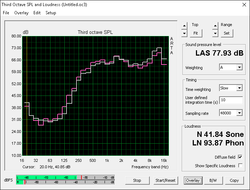
The P34 series may have the power of some 17-inch notebooks, but its thin profile can only do so much with internal speakers. Sound quality is lacking in bass and feels narrow in range when playing games or listening to music. There are no external audio options except for 3.5 mm earphones whereas larger gaming notebooks can have SPDIF, external 7.1, and Line-in ports.
Battery Life
Runtimes are overall shorter than the P34W v3 and very similar to the Razer Blade 14 even though the latter is equipped with a denser battery pack. The results are strange as we expected the Skylake-equipped P34W v5 to outlast its Haswell predecessor under similar testing conditions. It's possible that the differences in operating systems and potential background activities are working against the P34W v5. The system would sometimes automatically restart in the midst of running our WLAN test (prompting multiple reruns) despite turning off Windows automatic updates. Whether or not this is specific to the Xotic PC edition or the entire P34W v5 line is unknown.
A charge from empty to full will take approximately 2 hours and 15 minutes.
| Gigabyte P34W v5 61 Wh | Gigabyte P34W V3 61 Wh | Razer Blade 14 2015 71 Wh | MSI GS40-6QE16H11 61 Wh | Lenovo ThinkPad T450s-20BWS1UT00 96 Wh | Lenovo Yoga 700-14ISK 80QD 45 Wh | |
|---|---|---|---|---|---|---|
| Battery runtime | 55% | 10% | 11% | 331% | 91% | |
| Reader / Idle (h) | 6.5 | 8.7 34% | 6.3 -3% | 5.2 -20% | 31 377% | 12.5 92% |
| WiFi v1.3 (h) | 3.9 | 3.7 -5% | 5 28% | 10.8 177% | 6.1 56% | |
| Load (h) | 0.8 | 1.4 75% | 1.1 38% | 1 25% | 4.3 438% | 1.8 125% |
| WiFi (h) | 4.7 |
Pros
Cons
Verdict
In terms of raw performance, the P34W v5 matches many gaming notebooks twice its size. There is otherwise a very marginal performance boost compared to the P34W v3 aside from the throttling hotfix, so users should not be expecting runaway improvements to CPU power by jumping from the Core i7-4720HQ in the P34W v3 to the more power-efficient Core i7-6700HQ in the P34W v5. Instead, users who want the P34W v5 should make full use of its USB Type-C, DDR4, and HDMI 2.0 updates to get the most out of the model.
As for the WQHD configuration, we especially like that it offers very fast response times with higher contrast than the FHD P34W v3, but its gamut is narrower and with a slightly lower backlight brightness as a result of the resolution increase. Users may want to consider the FHD configuration instead especially since G-Sync is not supported on the WQHD version where the Nvidia technology would have been more beneficial. Despite some lingering drawbacks and the expected temperatures and fan noises when under load, the portable P34W v5 is a solid 14-inch gaming solution in a category with few other alternatives.
The latest P34W update uses the full power of its Skylake and Maxwell processors with no throttling when gaming while remaining very thin and lightweight for travel and classwork.
Gigabyte P34W v5
- 02/29/2016 v5 (old)
Allen Ngo




